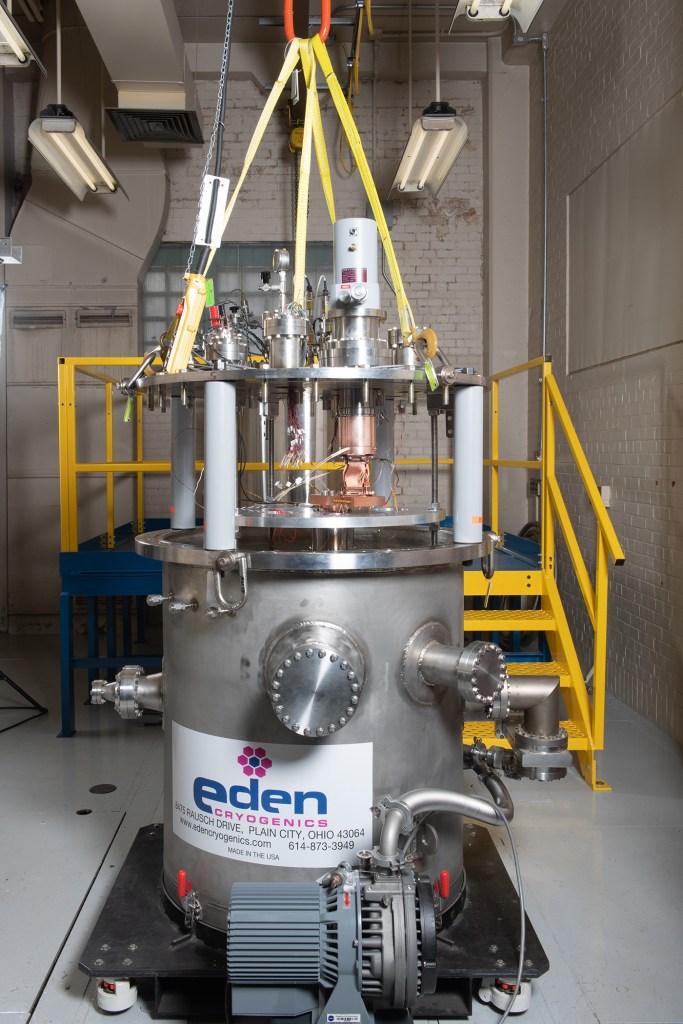Following their return from the inaugural flight of Space Shuttle Columbia, STS-1 astronauts John W. Young and Robert L. Crippen received honors at the White House for their heroic mission. Young and Crippen visited NASA’s Kennedy Space Center (KSC) in Florida to thank employees there who prepared Columbia for their mission and helped unveil a new stamp to commemorate America’s space achievements. Columbia returned to Kennedy, and ground crews began processing the orbiter for its next mission. Aiming for a Sept. 30, 1981 launch, the STS-2 crew of Joe H. Engle and Richard H. Truly, as well as ground personnel, participated in activities to prepare for the flight. Several senior management changes took place at NASA following the successful completion of the STS-1 mission.
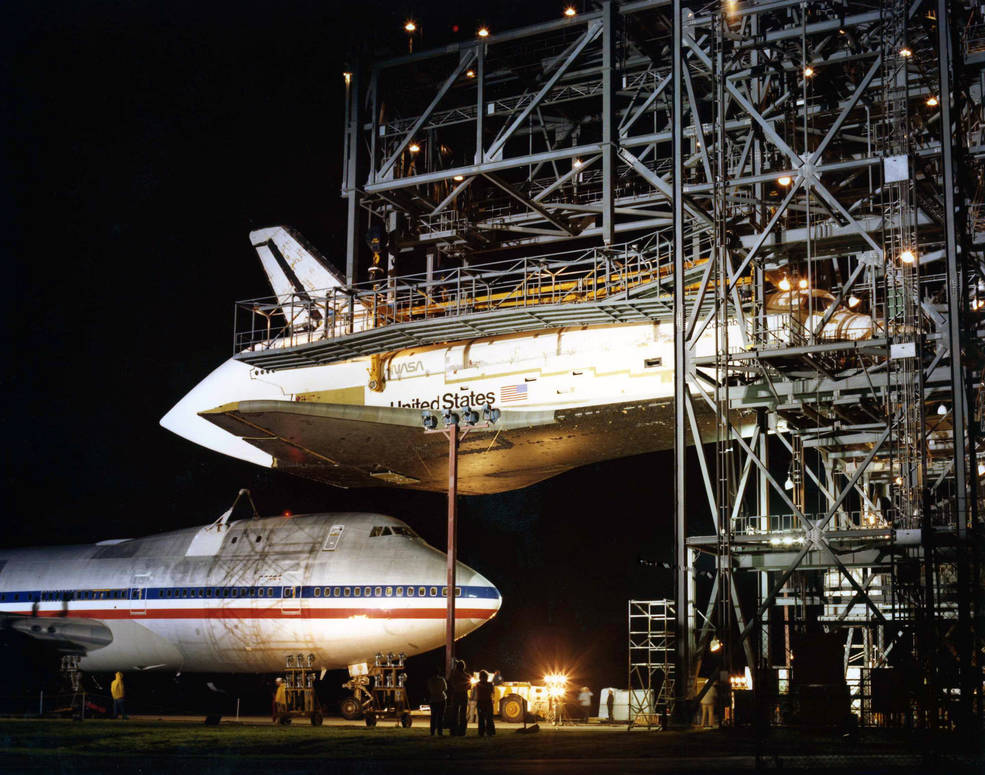
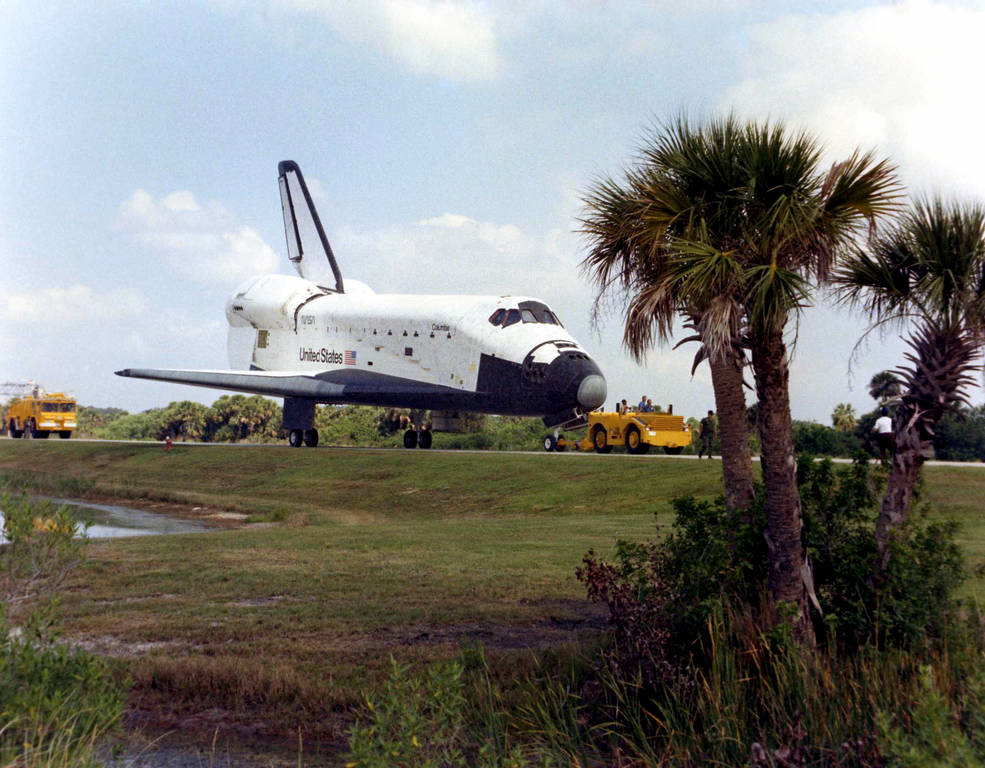
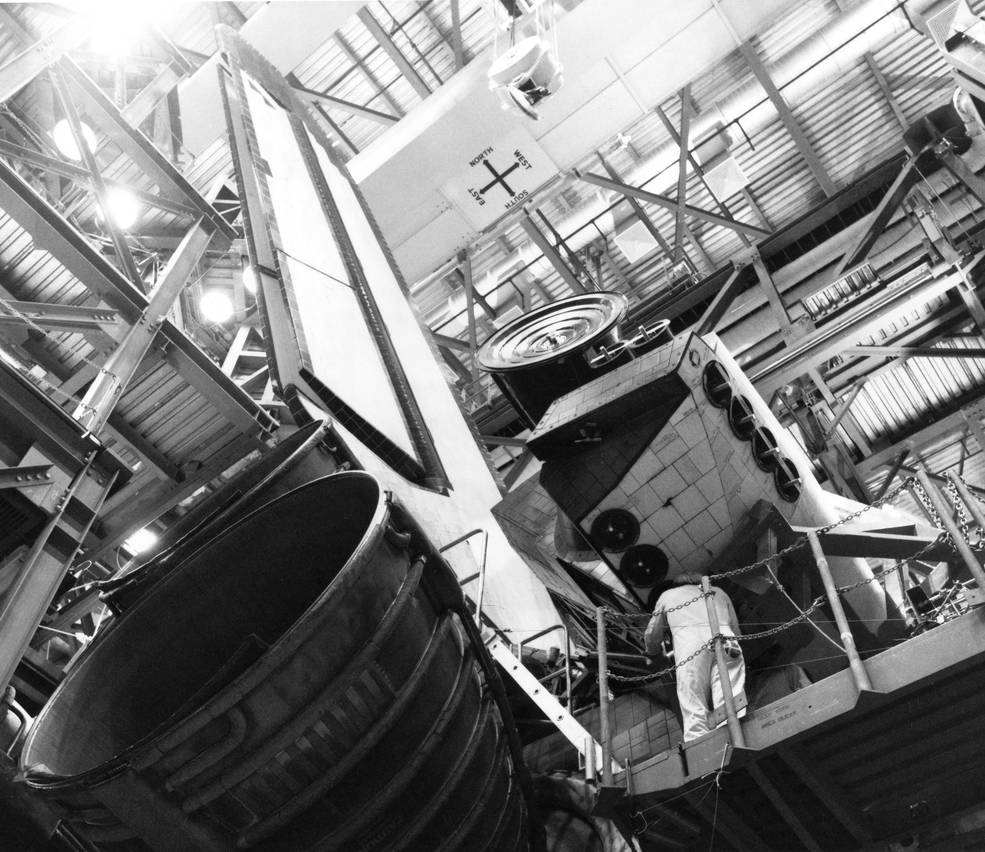
Left: At NASA’s Kennedy Space Center in Florida, ground crews lift space shuttle Columbia from the Shuttle Carrier Aircraft in the mate-demate device. Middle: Ground crews tow Columbia from the Shuttle Landing Facility to the Orbiter Processing Facility (OPF). Right: In the OPF, workers remove Columbia’s orbiter maneuvering system pods for refurbishment for the next mission, STS-2.
Following Columbia’s landing on April 14, 1981, at the Dryden Flight Research Center, now NASA’s Armstrong Flight Research Center in California, ground crews prepared it for the ferry flight back to KSC by mounting it atop the Shuttle Carrier Aircraft (SCA), a modified Boeing-747. Columbia arrived at KSC on April 28 and ground crews began inspections of the vehicle to prepare it for its return to space on the STS-2 mission targeted for no earlier than Sep. 30, 1981.
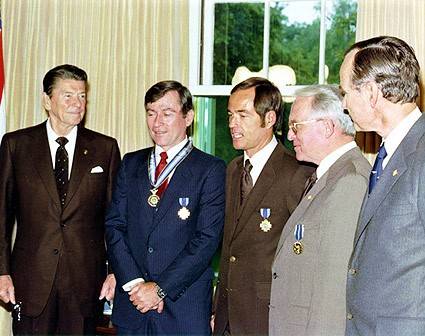
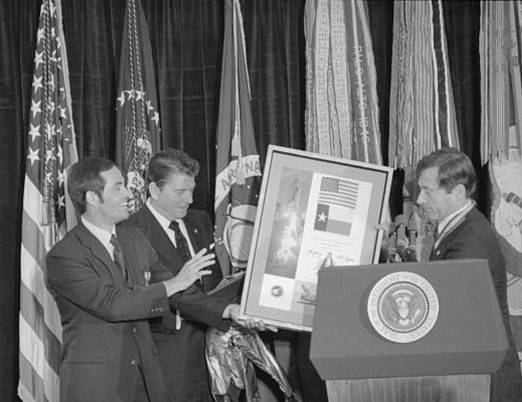
Left: In the White House, President Ronald W. Reagan, left, STS-1 Commander John W. Young, STS-1 Pilot Robert L. Crippen, NASA Administrator Alan M. Lovelace, and Vice President George H.W. Bush. Right: At the White House, Crippen, left, and Young present President Reagan with a signed photo montage to commemorate their historic mission.
On May 19, as 40 astronauts and other dignitaries looked on, President Ronald W. Reagan awarded Young and Crippen Distinguished Service Medals for successfully completing the first flight of a reusable spacecraft during a White House ceremony. Young also received a Space Medal of Honor for his five spaceflights during two decades as an astronaut. Acting NASA Administrator Alan M. Lovelace received the presidential citizen’s award, only the fourth person to receive the award since its establishment in 1969. The President described the space shuttle as “the world’s first true space transportation system,” saying it would affect American life in both subtle and dramatic ways, “bringing energy and excitement to our national reserve.” Young and Crippen in turn presented the President and Vice President George H.W. Bush with American flags they had carried on the shuttle’s first flight. They also gave the President a gold spaceflight jacket with the presidential seal, prompting President Reagan to respond, “You won’t mind if I only wear this in Earth’s atmosphere.”
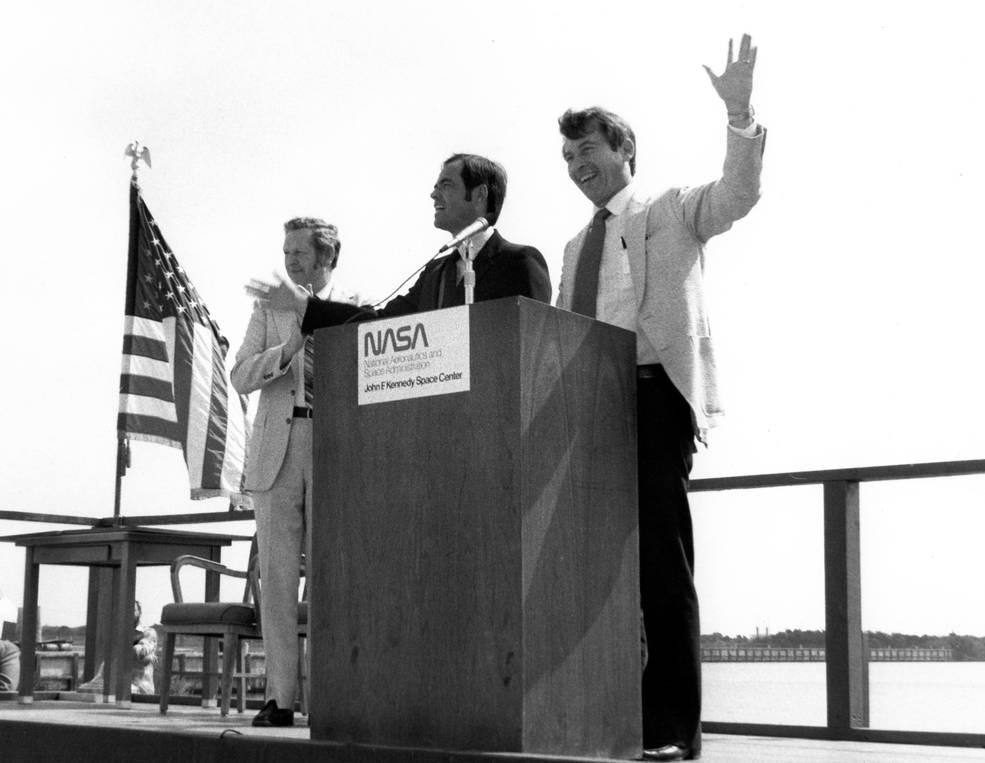
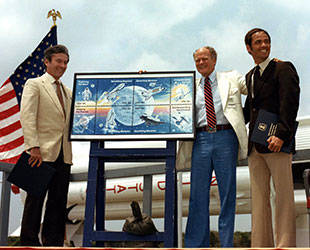
Left: Director of NASA’s Kennedy Space Center (KSC) Richard G. “Dick” Smith, left, welcomes STS-1 astronauts Robert L. Crippen and John W. Young to KSC. Right: During the KSC ceremony, Young, left, and Crippen, right, help unveil space artist Robert T. “Bob” McCall’s design of space achievement stamps, released by the U.S. Postal Service on May 21, 1981.
On May 21, Young and Crippen visited KSC to thank employees there for their efforts to prepare space shuttle Columbia for its historic mission and inspect the vehicle as workers prepared it for its next flight. “This is a family welcome and we’re proud to have you back,” KSC Director Richard G. “Dick” Smith told Young and Crippen during the ceremony. In addition to the large crowd of NASA and contractor employees, U.S. Representative C. William “Bill” Nelson, now NASA administrator, Shuttle Projects Office Manager Robert H. “Bob” Gray, and Launch Director George F. Page also attended the ceremony. “You really did a good job,” Young told the audience. “The vehicle worked just superbly. I sure want to thank you.” During the same ceremony, the U.S. Postal Service released the Space Achievement commemorative issue, a block of eight 18-cent stamps. Designed by noted space artist Robert T. “Bob” McCall, the central image shared by four individual stamps depicted the space shuttle, with four additional side stamps depicting lunar exploration, the Skylab space station, the Pioneer 11 probe to Jupiter and Saturn, and the then-planned Hubble Space Telescope.
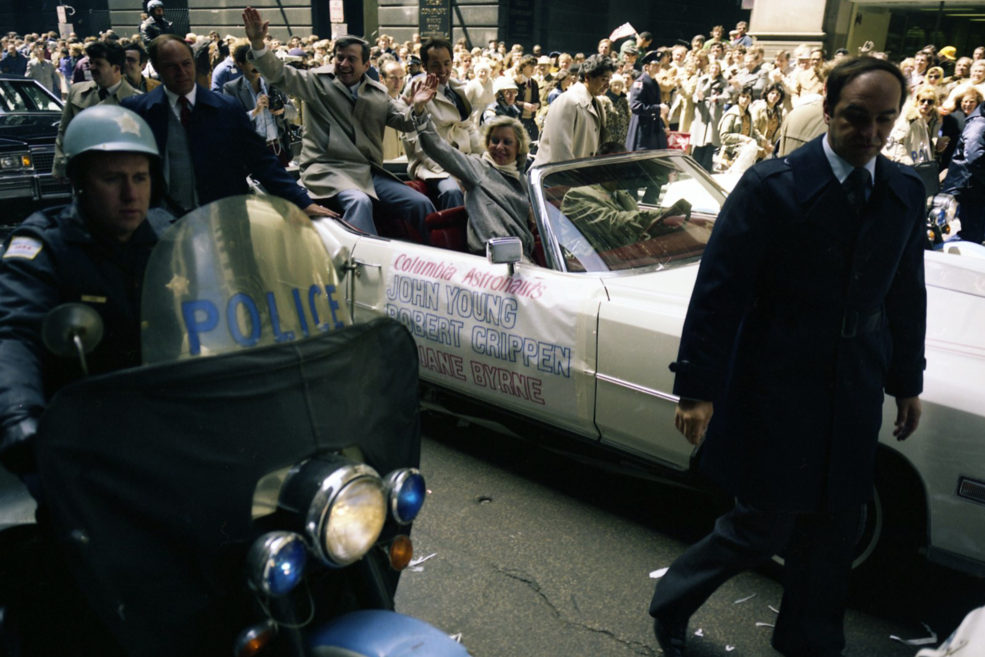
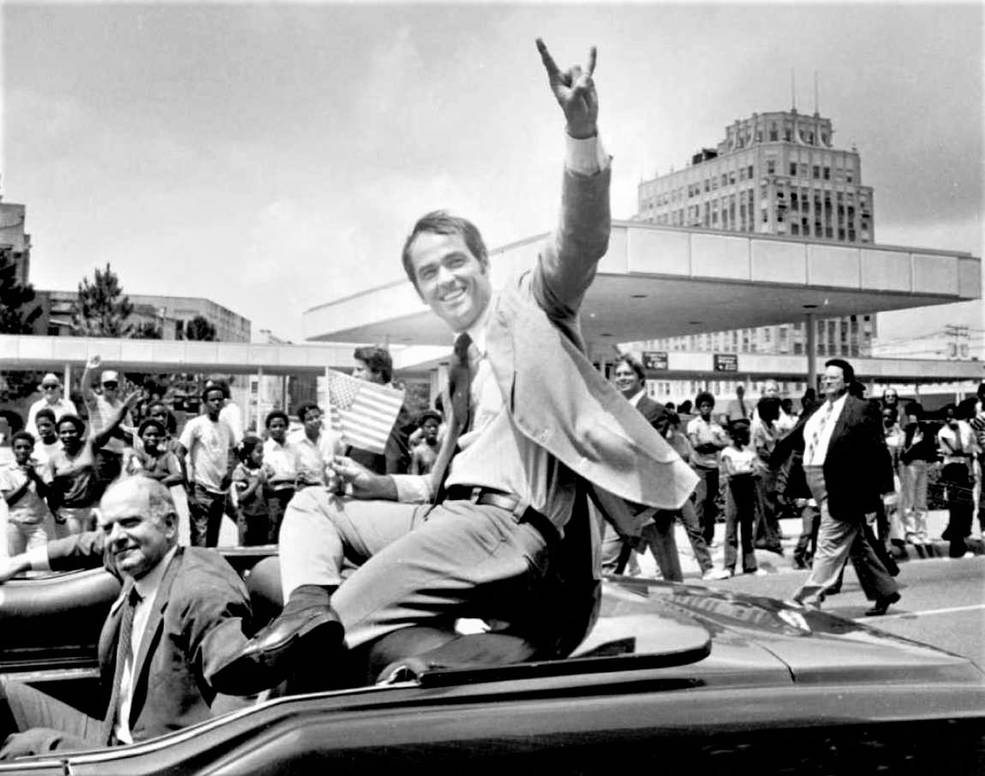
Left: In Chicago, STS-1 astronauts John W. Young, left, and Robert L. Crippen riding in a motorcade with Mayor Jane M. Byrne. Credit: Image courtesy Chicago Police Department. Right: Crippen riding in a motorcade in his hometown of Beaumont, Texas, with Mayor Maurice “Maury” Meyers. Credit: Image courtesy Beaumont Enterprise.
Many cities welcomed the STS-1 astronauts to help celebrate the success of their mission. The city of Chicago feted Young and Crippen with a ticker tape parade on May 6, with the astronauts riding in Mayor Jane M. Byrne’s car. They addressed a crowd of well-wishers and presented Mayor Byrne with mementos from their mission. Crippen visited his hometown of Beaumont, Texas, on May 18-19, riding in a motorcade with Mayor Maurice “Maury” Meyers. In one of their more far-flung visits, Young and Crippen traveled to Australia to thank the workers at the Orroral Valley tracking station near Canberra for their support during their mission. During the July 1, 1981 visit, station director Lewis Wainwright provided Young and Crippen with a tour of the facility and the kitchen staff baked a special cake topped with a space shuttle for the welcome lunch.
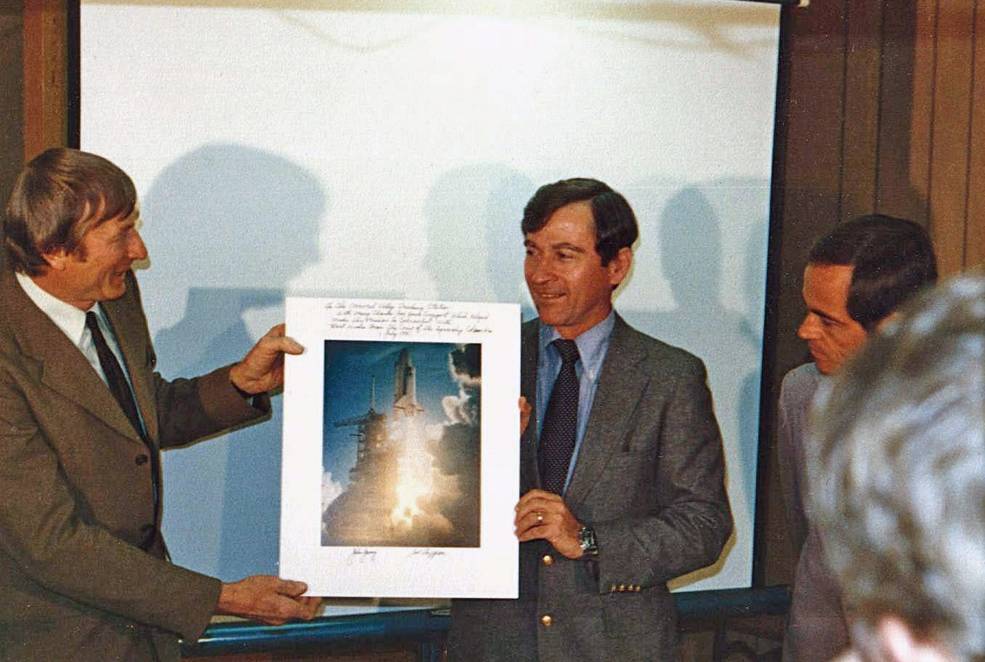
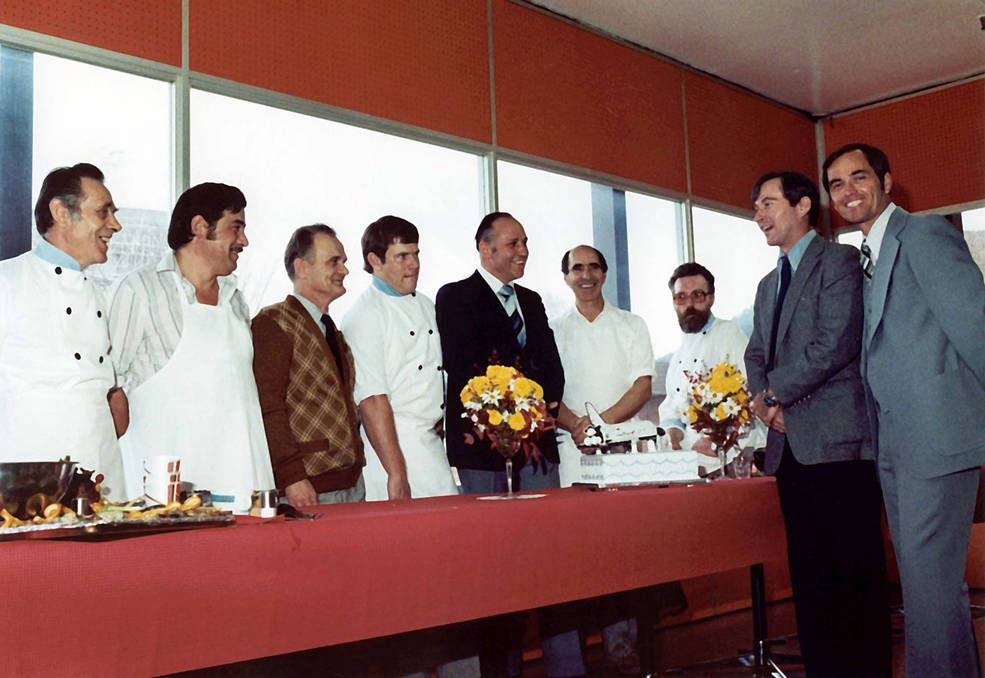
Left: During their visit to the Orroral Valley tracking station in Australia, STS-1 astronauts John W. Young, center, and Robert L. Crippen present a signed photograph of their launch to the facility’s director Lewis Wainright. Right: Young and Crippen, right, during the welcome lunch – note the special cake with a space shuttle on top. Credit: Images courtesy honeysucklecreek.net.
Several management changes took place at NASA following the successful completion of the STS-1 mission. On April 23, President Reagan nominated James M. Beggs as NASA administrator to succeed Acting Administrator Lovelace. The U.S. Senate confirmed Beggs on June 25, and Vice President Bush swore him in on July 10. Ten days later, Beggs attended the dedication of the Teague Visitor Center and Auditorium at NASA’s Johnson Space Center in Houston, named after Congressman Olin E. “Tiger” Teague of Texas, a long-time supporter of the space program. Beggs told the assembled audience, “Keep up the magnificent things that you’ve done in the past and I assure you that we’ll have success.” Later that same day, July 20, the 12th anniversary of the first Moon landing, Beggs returned to Washington, D.C., to attend a ceremony at the White House with President Reagan and Apollo 11 astronauts Neil A. Armstrong, Michael Collins, and Edwin E. “Buzz” Aldrin.
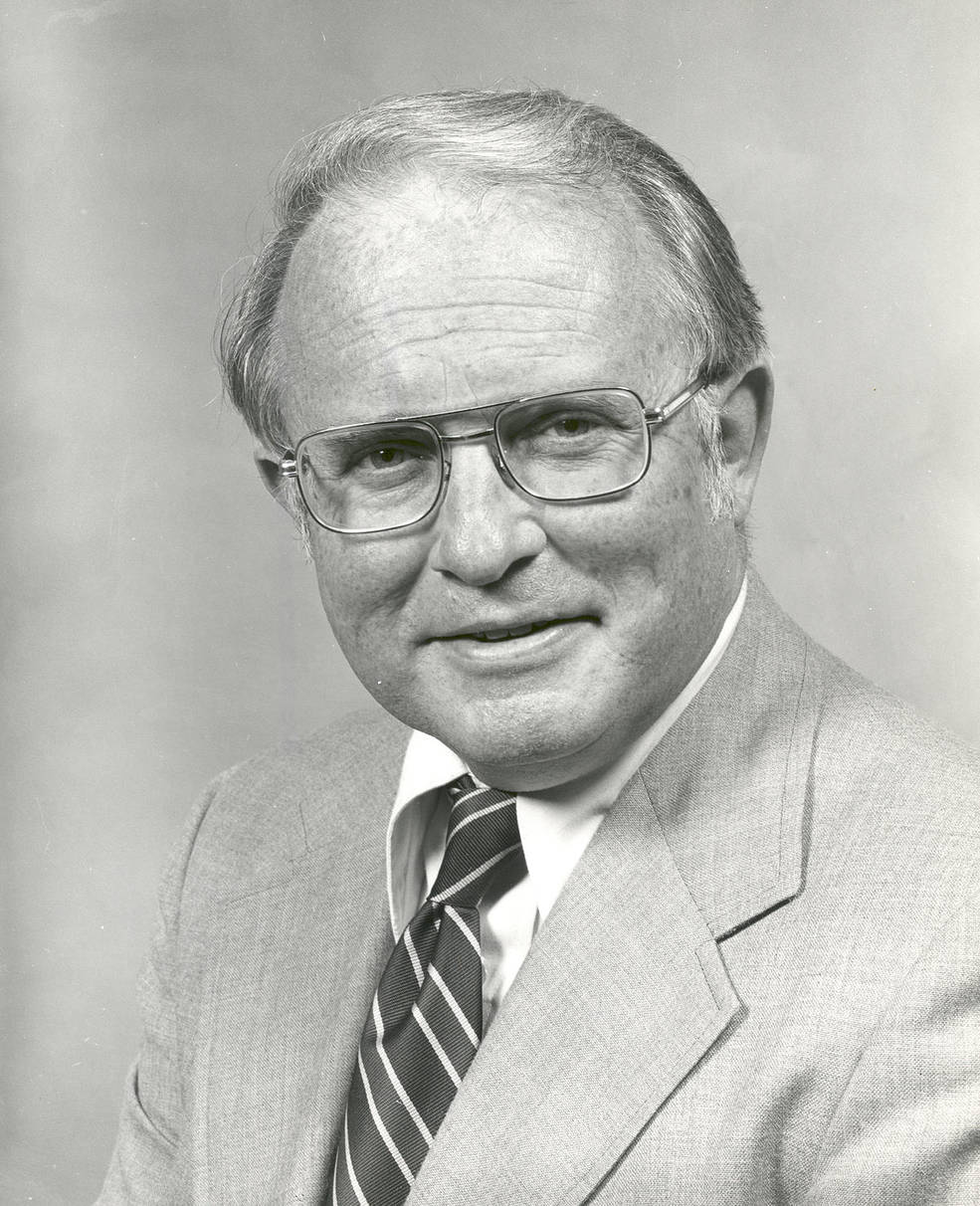
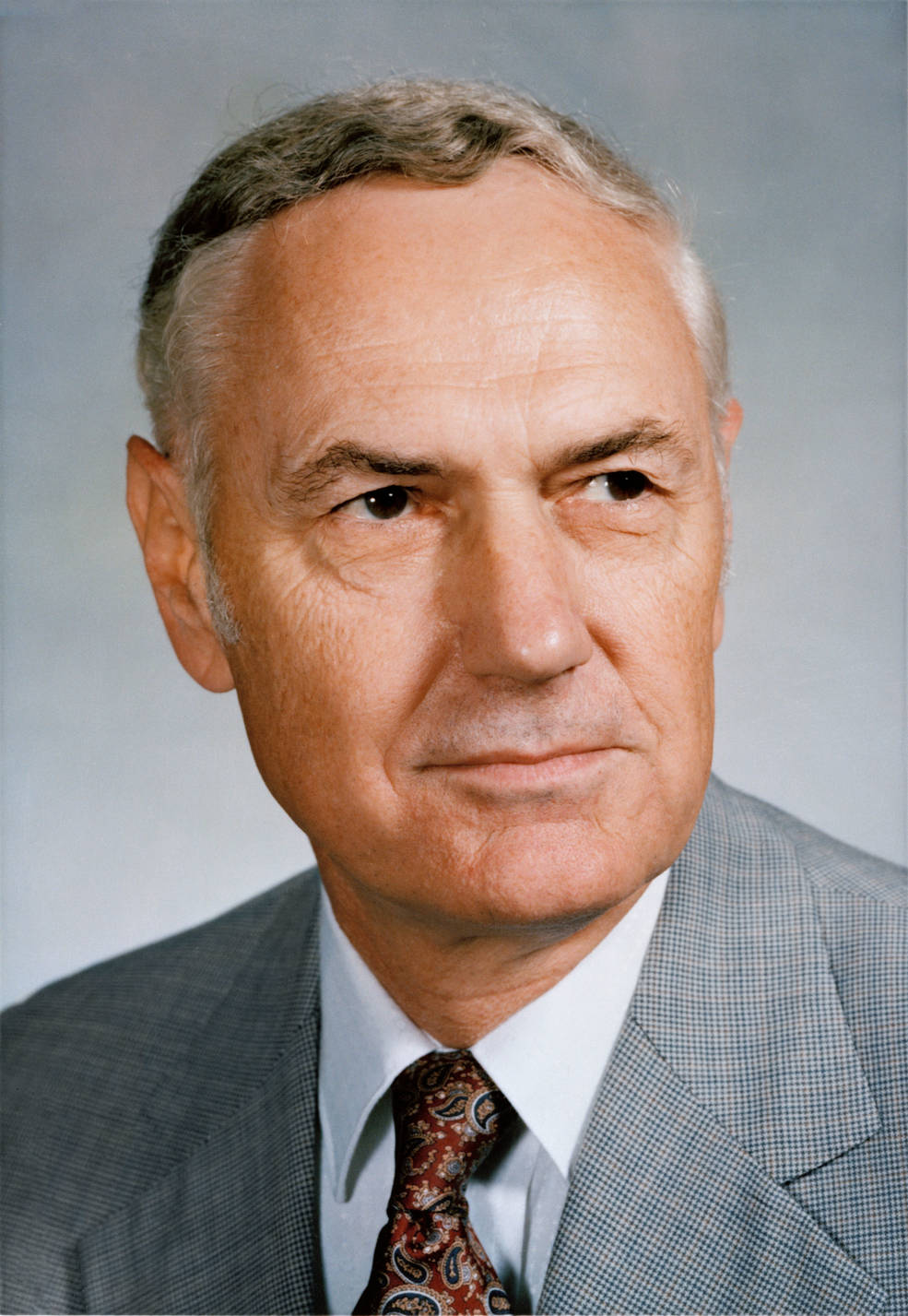
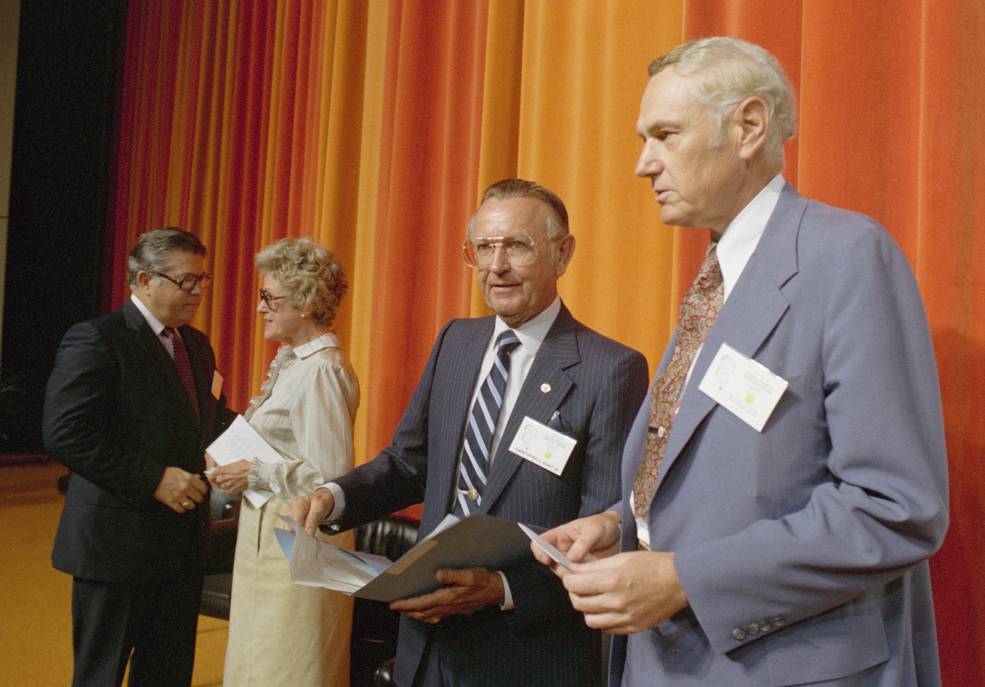
Left: Official NASA portrait of Acting NASA Administrator Alan M. Lovelace. Middle: Official NASA portrait of Administrator James M. Beggs. Right: Administrator Beggs, right, at the dedication of the Olin E. Teague Auditorium at NASA’s Johnson Space Center (JSC), along with Representative Teague’s widow Freddie Dunman Teague and JSC Center Director Christopher C. Kraft.
Among other management changes, Robert F. “Bob” Thompson retired June 5 as manager of the Space Shuttle Program Office, a position he held since the office’s establishment in February 1970. Glynn S. Lunney succeeded Thompson. John F. Yardley, NASA’s associate administrator for space transportation systems, left NASA effective June 1 to become president of McDonnell Douglas Astronautics Co. Yardley’s deputy, L. Michael Weeks, succeeded him as acting associate administrator. Astronaut Alan L. Bean, the fourth man to set foot on the Moon during the Apollo 12 mission in November 1969, announced he would resign from NASA effective June 26 to devote full time to his career as a painter. Bean commanded the second Skylab mission in July-September 1973, and at the time he held the American record for total time spent in space, 69 days. He noted that in his 18 years as an astronaut he had seen sights no artist had ever viewed firsthand, and he hoped to record his experiences through his art. Bean served as head of astronaut-candidate operations and training at the time of his retirement, having overseen the training of the 35 new astronaut candidates selected by NASA in January 1978.
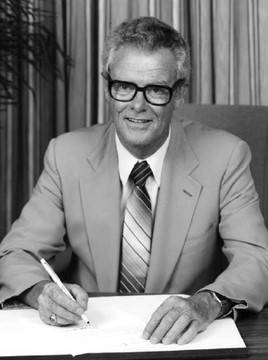
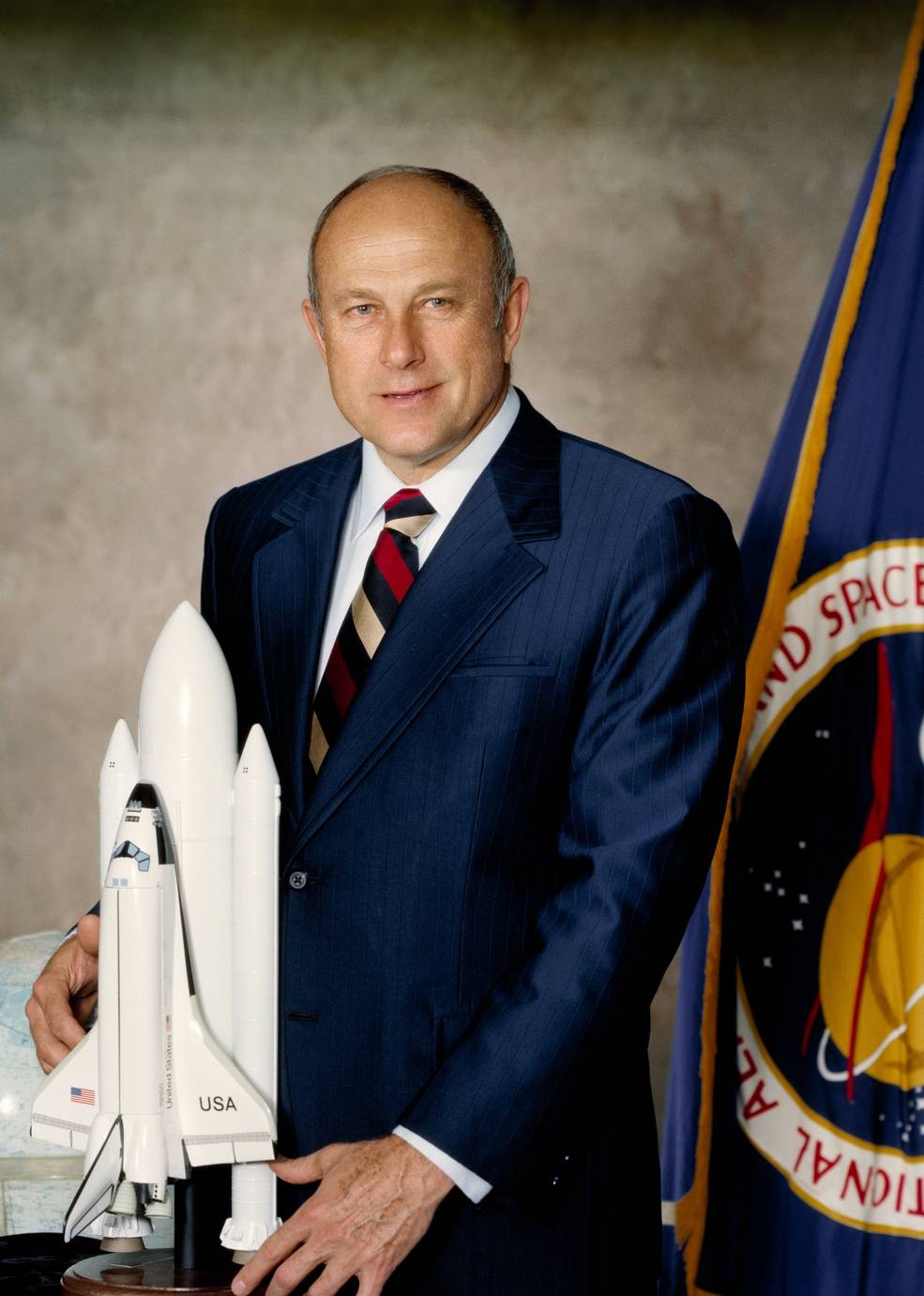
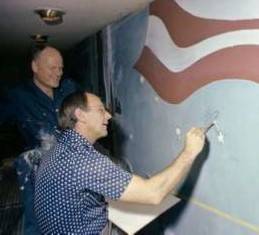
Left: NASA Associate Administrator for Space Transportation Systems John F. Yardley. Middle: Manager of the Space Shuttle Program Office Robert F. “Bob” Thompson. Right: In 1979, astronaut Alan L. Bean contributing to the mural outside the Teague Auditorium at NASA’s Johnson Space Center in Houston, as space artist Robert T. “Bob” McCall looks on.
With Columbia back at KSC, preparations ramped up for STS-2, the first reflight of a reusable spacecraft. In the Orbiter Processing Facility (OPF), ground crews inspected the vehicle and found it to be in remarkably good shape after its first flight in space. About 1,300 tiles of the orbiter’s thermal protection system required replacing. Workers installed the Spacelab pallet containing the five experiments of the Office of Space and Terrestrial Applications-1 (OSTA-1) payload, and the Canadian-built remote manipulator system (RMS) or robotic arm into Columbia’s payload bay on June 29. STS-2 marked the first flight of science experiments and the first use of the RMS. In the Vehicle Assembly Building (VAB), the external tank (ET) for STS-2 arrived on April 22 to undergo inspection and checkout. Workers completed assembly of the twin solid rocket boosters (SRBs) on the mobile launch platform in early June and mated the ET with the SRBs on June 30. A two-day Orbiter Interface Test was completed on July 29 in preparation for the rollover of Columbia from the OPF to the VAB on August 10 for mating with the ET/SRB stack.
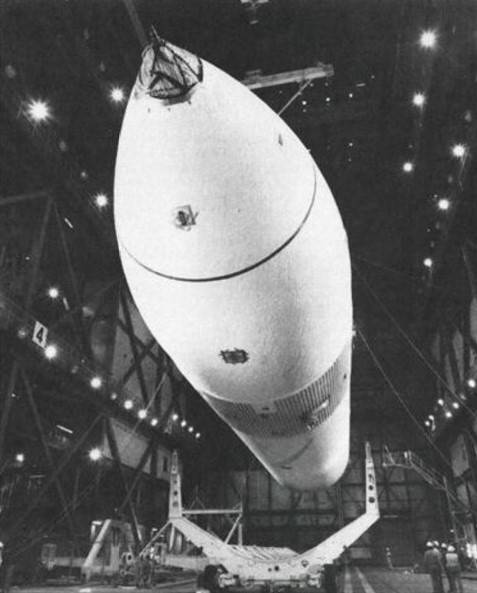
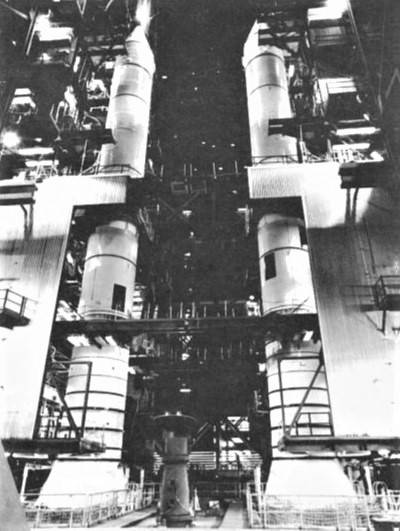
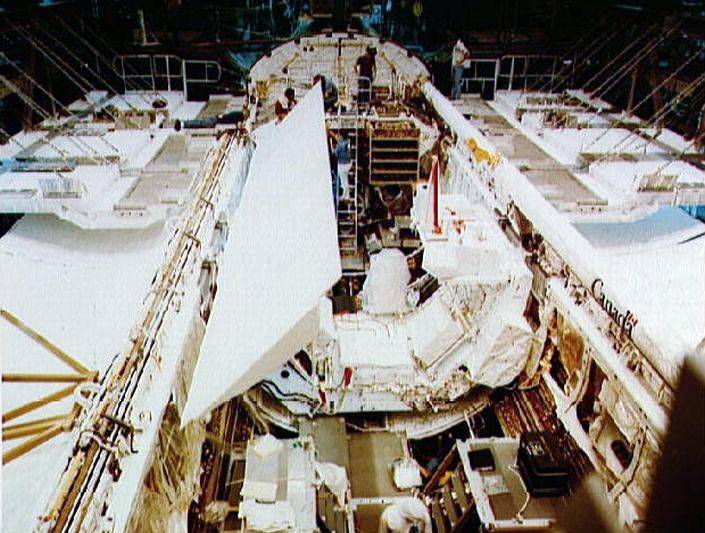
Left: The external tank for the STS-2 mission shortly after its arrival in the Vehicle
Assembly Building (VAB) at NASA’s Kennedy Space Center in Florida. Middle: The solid
rocket boosters stacked on the mobile launch platform inside the VAB. Right: In KSC’s
Orbiter Processing Facility, the OSTA-1 payload and the Canadian-built remote
manipulator system installed in Columbia’s payload bay.
In the Mission Control Center at JSC, flight controllers completed the first long-duration 33-hour simulation of the STS-2 mission on July 7-8. New Flight Directors Tommy W. Holloway and Harold M. “Hal” Draughan joined STS-1 veterans Neil B. Hutchinson, Charles R. “Chuck” Lewis, and Donald R. Puddy in heading the flight control teams. Astronaut Sally K. Ride participated as the capsule communicator (capcom), the first woman to serve in that key position as the one person who talks directly with the crew. STS-2 astronauts Engle and Truly participated in the simulation in JSC’s fixed base shuttle mission simulator. The crew also participated in other simulations and practiced using the RMS.
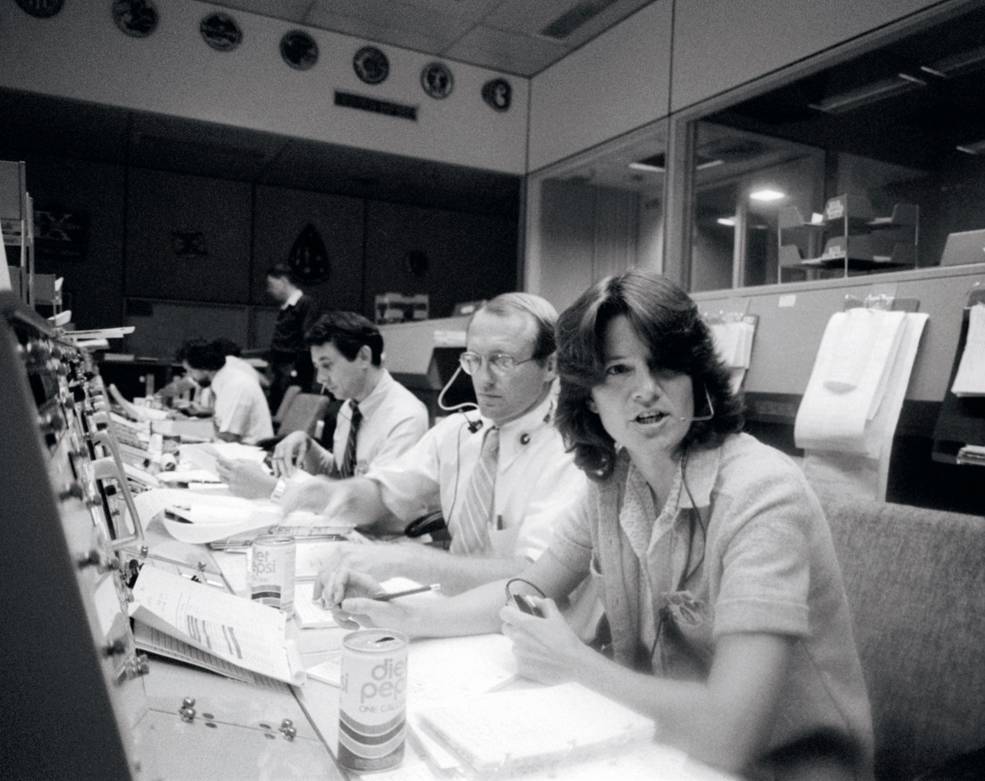
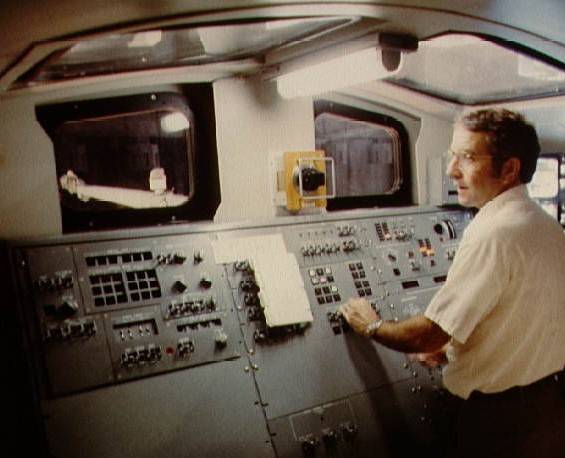
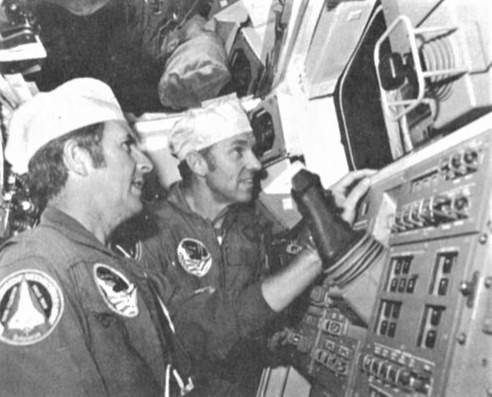
Left: Astronaut Sally K. Ride, left, serving as capsule communicator during a simulation for the STS-2 mission in the Mission Control Center at NASA’s Johnson Space Center (JSC) in Houston. Middle: STS-2 Pilot Richard H. Truly practicing using the shuttle remote manipulator system in a simulator at JSC. Right: STS-2 Pilot Truly, left, and Commander Joe H. Engle on Columbia’s aft flight deck during the orbiter interface test.
To be continued…
World events in May 1981:
May 1 – American Airlines begins the first frequent-flyer program.
May 1 – Tennis star Billie Jean King becomes the first professional athlete to identify as LGBTQ.
May 7 – Standup comedian Jerry Seinfeld performed for the first time to a national audience on The Tonight Show.
May 11 – Andrew Lloyd Weber’s musical Cats performed for the first time.
May 11 – Reggae artist Bob Marley dies at age 36.
May 13 – Pope John Paul II survives an assassination attempt in The Vatican.
May 16 – Soyuz 40, carrying Romanian cosmonaut Dumitri Prunariu and veteran Soviet cosmonaut Leonid Popov docks with the Soviet Salyut-6 space station.
May 18 – The first news article appears about Acquired Immuno-Deficiency Syndrome (AIDS).
May 21 – François Mitterand inaugurated as president of France.


















